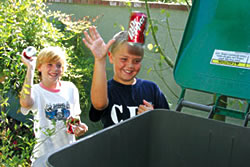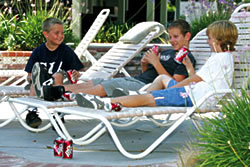EAT, DRINK & PLAY - ENTERTAINMENT
Read This Article, Then Recycle It
October, 2005 - Issue #12
 |
While many citizens are pretty good at throwing plastic water bottles into recycling cans, odds are if you dump out the contents of an average kitchen trash compactor, you'd find most of the trash inside can also be recycled.
A state law was passed requiring all California cities to reduce their waste to a 50-percent diversion rate by the year 2000, but half of the 445 municipalities have had problems meeting that recycling goal and some have asked for extensions. Santa Clarita's extension ends this year. If the 50 percent rate has not been met, the city will be fined up to $10,000 a day. According to the latest figures (from 2003), Santa Clarita is recycling about 40 percent of its waste.
Recycling is mandatory in Santa Clarita and city officials have embarked on an aggressive campaign to reach that 50 percent goal.
"The main reason people do not recycle, in my opinion, is it is not convenient," said Chris Fall, public sector services manager for Waste Management/Blue Barrel. WM/BB hauls all residential trash within the boundaries of the city and from homes and businesses in Stevenson Ranch, Castaic and Agua Dulce.
"If you are home and you only have a trash cart in your kitchen and your recycle bin is in the garage, where will you put that water bottle?," Fall asks. "Education is extremely important. If everyone knew that it takes about 700 years for that plastic bottle to biodegrade and it is worth about four cents, would they take it to the garage or would they add a recycle cart in the kitchen?"
In Santa Clarita, glass, aluminum, steel, tin, plastics, cardboard and other recyclables can all be placed in a single recycling container. A separate bin is given to residents for green waste such as yard clippings.
Residents are urged to utilize reusable materials, such as canvas shopping and grocery bags and cloth napkins and towels and to buy rechargeable batteries. Purchasing items made of recycled materials also benefits the environment.
"Landfill sites are finite," said Ben Lucha, environmental analyst in the city's Environmental Services Division. "You really don't want to put a landfill near a residential area."
Teaming up with KHTS-AM 1220 and Waste Management/Blue Barrel, city officials want to reward citizens for recycling. Beginning this summer and through December, the KHTS-AM 1220 disc jockeys will roam residential streets looking for full recycling bins sporting WE RECYCLE stickers. Every week, a handful of residents will be selected for their recycling efforts and be rewarded with tickets to Six Flags California, the movie theater, sporting events and other prizes. Weekly winners will be eligible for a monthly drawing for a full year of free trash service from Waste Management/Blue Barrel.
The Environmental Services division has developed several other environmental and pollution prevention programs to help residents increase the amount of trash diverted from landfills. The city's website is loaded with recycling tips as well as the location of several local redemption centers.
Commercial trash can weigh much more than average household trash, such as in the case of concrete. Diversion rates are based on weight. The city recently adopted a Construction and Demolition Materials (C&D) ordinance requiring large construction and demolition projects to recycle at least 50 percent of generated waste. Developers will be required to prepare recycling plans and submit a refundable deposit to be returned once the recycling has been completed.
And while many shopping centers and office buildings have separate containers for recycling with enthusiastic participants, it becomes a problem when those bins are not discarded properly.
"We will be spending more time with the businesses to help figure out what it is that can actually be recycled," said environmental services manager Travis Lange. "There is concern (regarding the C&D Ordinance) and we have held workshops. Most of the people coming out of the workshop feel more comfortable. There is an understanding we have to comply with the new legislation."
Burrtec Waste Industries, Inc., the commercial trash hauler, is contractually required to build a material recovery facility and has proposed a site within the city limits. A MRF is a facility that is used to separate recyclables collected from the commercial and residential recycling programs. One of the benefits of the MRF will be that 50 to 65 percent of the commercial waste collected will be recycled. The proposed facility in the Gates/King project, however, has been stalled due to a pending lawsuit. Burrtec was granted an extension.
Can babies be a problem when it comes to the environment? The answer is yes when it comes to disposable diapers and there are lots of babies in the Santa Clarita Valley. An innovative diaper recycling plant was discontinued after a nine month period, however, when officials found it cost prohibitive.
 |
There are 40 other programs listed on the city's webpage. It's an ongoing process to get the city into compliance. "I can't think of anything we've not done or looked into doing," Lange said.
A 50 percent recycling rate makes sense - it is good for the environment and good for the community. Mayor Cameron Smyth said the city prides itself on being a clean and beautiful place to live and that will continue with recycling. "Achieving at least a 50 percent diversion rate is not only important for being in compliance with state law, it will also help maintain the quality of life in our community,' he said.
So what can the average citizen do to help? Start by recycling just about everything in that trash compactor.
"Junk mail, cardboard... When you pick up a piece of paper, it doesn't seem very heavy, but when you pick up a ream...," Lange said. "Does it make more sense to throw it in the ground and bury it or use it?"
Environmental fact: Aluminum cans take about 60 to70 years to degrade. Glass? A million years, because there is no degrading at all. You can recycle glass over and over and over. It will never loose quality.
Start by using the trash compactor for all of your recyclable products and place a small trash can under your kitchen sink for food products and other "non-recycling" waste. It is illegal to place oil and hazardous household products like pesticides, paints or gasoline into your family trash, as the poison will travel through the sewer system into the ocean. Be aware of the city's hazardous waste recycling days or call 800-HHW-PKUP to have Curbside Inc. come to your home and pick up those hazardous waste materials for free once a year.
Once these ideas become second nature, everyone will benefit. Chris Fall summed it up when he explained why recycling is his passion.
"We all live on this planet and we need to be aware of how we are taking care of it and what we can do to make it a better place for our families and children and their children," he said. "I tell my kids that am not a recycle freak for me, I am a recycling freak for them. They will be around, God willing, a lot longer than I will."
For more information on how, what and where to recycle, log on to the city's Environmental Services Division webpage at www.santa-clarita.com or Integrated Waste Management Board at www.ciwmb.ca.gov.
|
||||||||||||||||||||||||||||





